by Editor | Aug 6, 2012 | Accomodations
Photos by Gary Cox
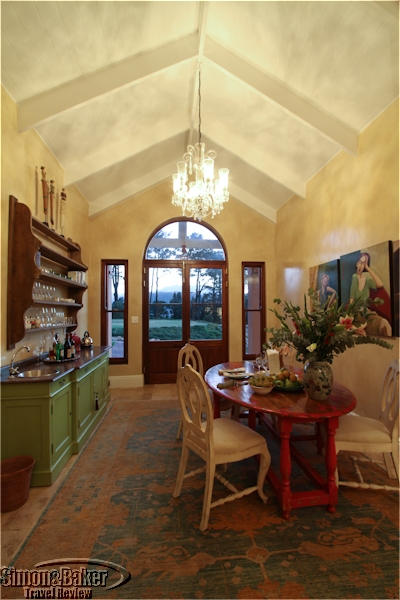
Entry to Villa 1 at La Residence
During a summer trip to South Africa Elena and Gary revisited La Residence Hotel and Villas in the tiny gourmet and wine producing town of Franschhoek about one hour’s drive from Cape Town. They were delighted with the discovery of a new section of the property that welcomed families (the hotel section was reserved for adults and children 12 and older). The Villas added a level of luxury and privacy to the boutique hotel.
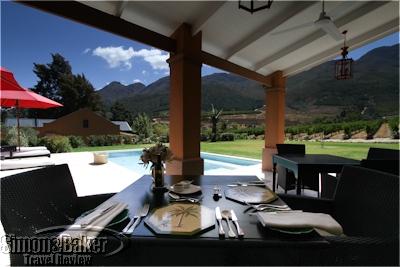
Breakfast looking out on the pool and vineyards
They stayed in a centrally air conditioned stand alone structure, one of several Villas facing the estate vineyards, with two bedrooms, a living and dining area, wet bar, lawn and private swimming pool. The accommodations included superlative service, numerous complimentary amenities including WiFi and local transfers, room service and two dining venues.
by Editor | Jul 30, 2012 | Accomodations, Attractions, Food and Wine
Article and photos by Elena del Valle
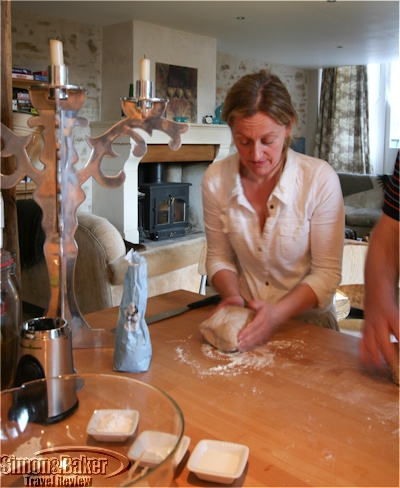
Katherine in class
In late April, I traveled to Burgundy, France for a six-night introductory cooking and culinary small group program with some behind-the-scenes features. Included in the English language program were comfortable and modern accommodations with daily room cleaning, meals, cooking demonstrations, transportation and activities with English speaking guides (a service tip was suggested though not required). As part of the program six of us shared Frelon’s Fabulous France, a five bedroom two-story recently renovated house with a working fireplace, complimentary WiFi connectivity, a private swimming pool and two enclosed courtyards (because of the cold that week the pool remained covered and the courtyards empty of guests).
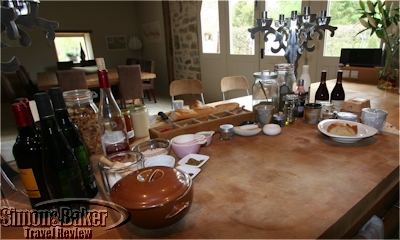
Prime space at the kitchen counter
The house, formerly used as horse stables, had been lovingly renovated by the owners, Katherine and Yannick Frelon, over an intensive 18 month period. The culinary program was led by Katherine, an English cook, and a group of her associates from the same country. It consisted of her cooking demonstrations with some hands on cooking opportunities for those so inclined, daily culinary or wine related excursions, and three non home cooked meals (one a la carte cafe lunch and two set menu gourmet restaurant meals, one lunch and one dinner).
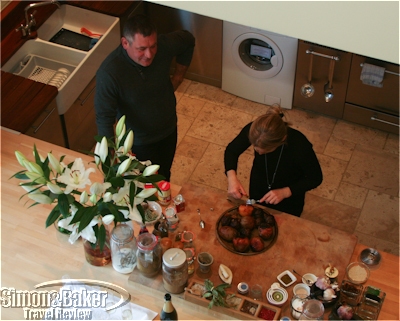
Katherine and Yannick in the kitchen
The house itself, especially the kitchen, was well appointed, spacious and comfortable. Located in Marigny Le Cahouet, a pretty and quiet country village fronting a brook and the famed Burgundy Canal, it provided a placid setting in spite of a rain filled week. The upside of the weather were the uncrowded Dijon market and tourist attractions we visited.
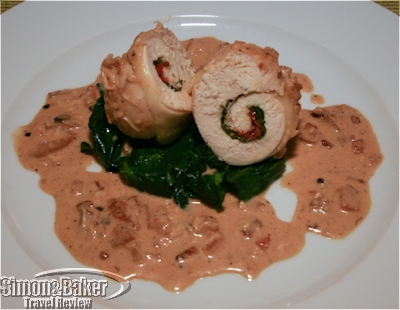
One of Katherine’s many dishes
Katherine, a part-time river barge and freelance cook who had lived in France for many years, dedicated time on four days to cooking demonstrations which resulted in lunch buffets and plated dinners for our group. The meals were prepared from regional fresh ingredients (some from her garden) by her, while we watched and sometimes participated, from her own recipes which she provided in a 72-page printed spiral bound handout on our arrival. Her cooking style, she explained when I asked at the conclusion of the week, is “seasonal, local, fresh and inspired” with recipes designed to translate to cooking students homes on their return to their country of residence.
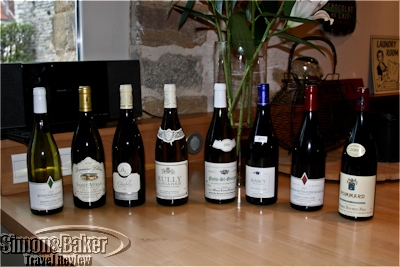
Our first activity was a wine tasting
At the beginning of the week, we were provided with a final itinerary without times or activity duration. Katherine would inform us of times and durations just before the activities on a daily basis or by leaving a printed card atop the kitchen counter. We ate most meals in the house dining room on the ground floor. Breakfast and lunch were self service buffet style and dinner was prepared and plated in the kitchen and served by Katherine or an assistant at the dinner table. Meal times varied depending on the day’s activities. A continental breakfast (hot beverages, self squeezed orange juice, bread, deli meats, cheeses, fresh fruit, yogurt, cold cereal, honey and jams) was usually available an hour or less before departure; lunch was usually served between 1 p.m. and 2:30 p.m. Dinner, usually after 8 p.m., lasted two or more hours.

Katherine demonstrated a cooking technique in class
Our days, spent mostly in each other’s company and with Katherine or a guide, were busier than I had anticipated. From breakfast through the end of dinner the majority of our waking hours were taken up by cooking demonstrations, scheduled activities or meals. That week I was reminded that spending time in close quarters with strangers with varied cultural and social backgrounds may be challenging. At times some of the attitudes and behaviors of other guests, particularly those who seemed to monopolize the conversation, complain and make unsolicited and unwelcome critical remarks, were grating and more than once spoiled the moment.
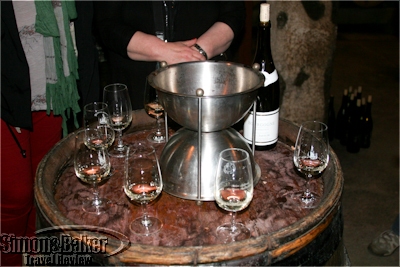
There were several wine tasting opportunities
During the week, there were two wine activities with different guides and visits with tastings to three small family owned wine makers. My favorite experiences by far were the introduction to Burgundy wines by Nancy, a knowledgeable Englishwoman with a ready smile, the first afternoon; and the behind the scenes visit and wine tasting at a Flavigny winery also in her company.
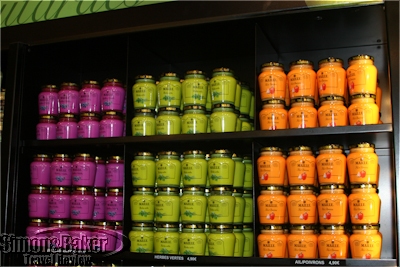
A stop at the Maille mustard shop in Dijon was included
There was a kitchen side cooking demonstration with guest participation at a gourmet restaurant, a visit to Dijon focusing on a market experience and cafe break, a mustard shop stop, a croissant making demonstration by the village baker in the house, and a chocolate shop visit with complimentary hot cocoa and a couple of bite size samples.
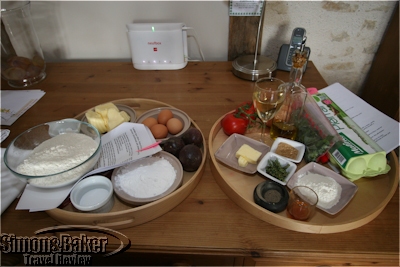
Ingredients for a recipe
On our last full day we went to two wine tastings. We also stopped in Beaune for a light lunch at a central cafe, an optional 30-minute visit with our wine guide to the Hospice de Beaune, a historic building and popular tourist attraction, and an hour at leisure for shopping enthusiasts (most of the shops were closed for 30 minutes of that time).
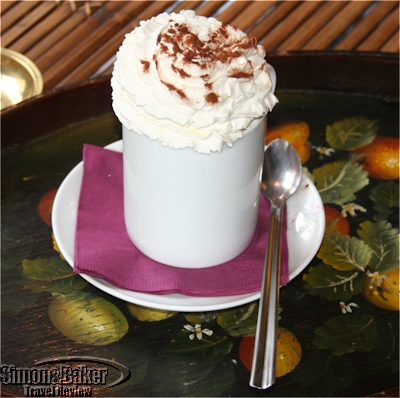
Hot cocoa at the Comptoir des Colonies near the Dijon market
The day after our arrival we drove to a gourmet restaurant in a pretty vineyard setting for a cooking demonstration with the chef followed by a kitchen-side lunch (not a favorite). Unfortunately the chef was in Singapore so the demonstration was conducted in English by one of his staff cooks, a personable Asian woman. Some of the ingredients were unavailable, she informed us at the beginning of the class and had to be substituted in the recipe. Although she tried several times she was unable to demonstrate the foam technique that was central to the recipe; instead of foam the device, when pressed, delivered liquid.

A visit of a cobble stoned street town
Our much anticipated final gourmet meal was at a highly rated restaurant about 30 minutes from the house. On our arrival we were greeted, in charming French accented English, by the owner. Although the restaurant dining room where we were seated faced a lovely garden, our corner table was near the rear of the room rather than the window and my seat faced the wall. A flute of champagne unexpectedly flavored with pear and laurel and a warm cheese pastry amouse bouche distracted me from my initial disappointment of the view. The highlight of the set dinner menu with two house wines was a raw shrimp appetizer and a well cooked river fish. The pigeon was well prepared and presented. I especially liked the tiny but savory thighbone.
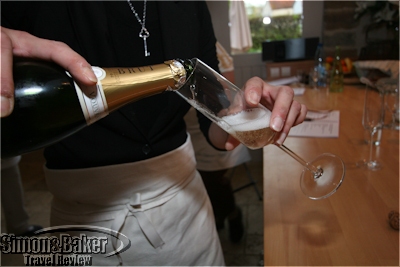
Bubbly was on offer in the afternoons
Following dessert the restaurant manager graciously invited us to the kitchen to meet the chef. While we enjoyed hot beverages in a lounge at the dining room entrance we were presented with a copy each of our menu with photos taken during our brief kitchen visit on the front cover as a memento of the night’s dinner, the closing activity for the week. By midnight we were back at the house and I was busy preparing for my early morning departure to catch the only daily train to the Charles de Gaulle Airport at the nearby Montbard station, a 20-minute drive from the house.
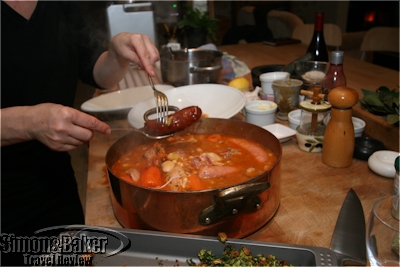
Cassoulet, one of my favorite dishes that week
I would recommend La Ferme de la Lochere (6 Rue de la Lochere, 21150 Marigny Le Cahouet, France, +33 672 86 5609, http://lafermedelalochere.com, katherine.frelon@lafermedelalochere.com) Burgundy culinary program to friends and acquaintances seeking an introduction to culinary Burgundy, related cooking demonstrations and behind-the-scenes activities with an English cook and team, in particular to groups wishing to book the program exclusively or to rent the house.
by Editor | Jul 9, 2012 | Accomodations
Article by Elena del Valle
Photos by Gary Cox
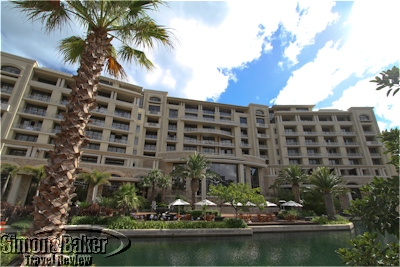
The One&Only hotel in Cape Town
We arrived by train in Cape Town at the end of the day on a Sunday. After we had finalized our itinerary we discovered the hotel we planned to spend the first night at was miles away from the city and to reach it we had to drive through an area under construction. Rather than drive unfamiliar roads under construction at night we opted to stay in the city. From among several choices, including two new five star properties, we chose the luxurious 131-room One & Only at the touristy and familiar V & A Waterfront area for our first night in the city.
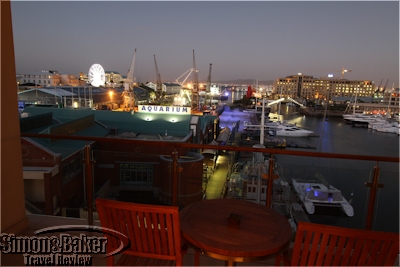
Looking out at the Waterfront from the room
We arrived a bit flustered because our rental car GPS didn’t list the hotel or accept its address and we missed the discreet sign of the One&Only as we drove by the building. On our second drive by we found the hotel. As soon as we entered the parking area a uniformed attendant, Charles, welcomed us and took charge of the rental car and luggage. Moments later, Kyle was guiding us through our check in process. We were greeted with a hot towel and soft drinks.
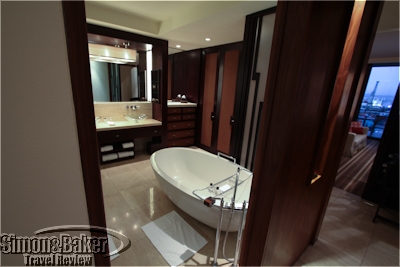
The large bathroom featured tub and shower
We were required to sign a registration form with a disclaimer that indicated the hotel was not responsible for guest property in the room and the hotel required a 1,500 rand reserve on each of our credit cards. No other property we had stayed at in South Africa or elsewhere had required we agree to such a disclaimer or required a signed credit card reserve. At my request my reserve was reversed on our departure the following day. Written confirmation of the reversal required two hours, the young man at reception explained.
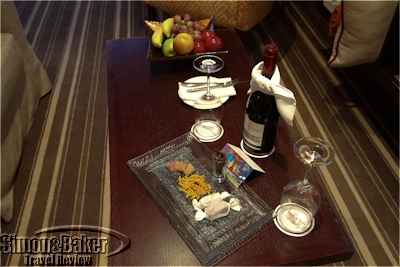
There were welcome amenities in our rooms
After we completed our check in Kyle kindly pointed out the main areas of the property and escorted us to our neighboring marina facing rooms (320 and 321). At my request our dinner reservations at Reuben’s (+27 21 431 4511), the hotel’s informal restaurant named for Reuben Riffel, a well known South African chef, were moved back 30 minutes to allow us time to freshen up and settle in our rooms.
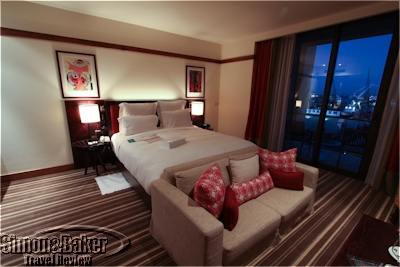
Sleeping and sitting areas in the spacious room
We liked that the pretty and spacious rooms shared an entrance foyer that could be closed (but not locked from the staff) with a hallway door for added privacy. After a few minutes we resolved, with the help of the hotel staff, a connectivity issue and went online. A few moments exploring my room revealed spotless, well appointed and air conditioned (the in-room materials explained that room temperature controls would be shut down while guests were out of the room) accommodations with two balconies, a large one with furniture one facing the neighboring Two Oceans Aquarium and the marina, and a smaller one facing the hotel spa and Table Mountain in the background. My travel partner’s room had one balcony facing the Aquarium.
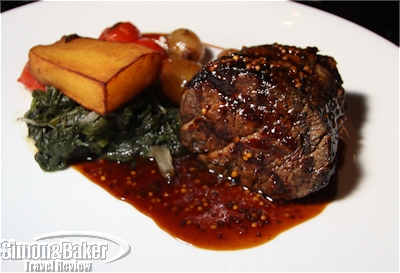
The flavorful Chalmar steak at Reubens
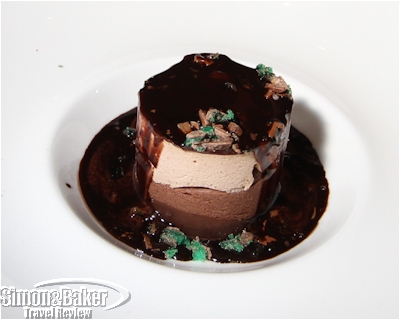
Dessert at Reubens
At Reuben’s, Dorothy welcomed us warmly and led us to our table for the night. The spacious two-story tall restaurant with a built-in three-level glass and steel wine storage wall housing 5,000 bottles and 600 references at the entrance and an open kitchen design was moderately busy. The highlight of dinner was my Chalmar rib eye steak, recommended by Lawrence Chiambah, our attentive waiter from Cameroon, when I asked about signature dishes.
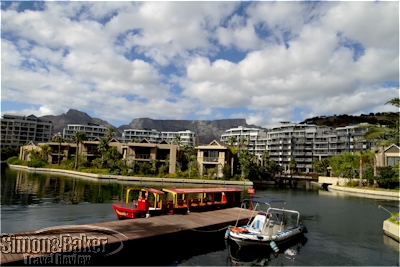
The water taxi just outside the hotel
With dinner behind us the excitement and fatigue of the day caught up with us. I longed for a steamy bath in my stand alone oval bathtub but settled for some time online and the speedy hot shower since we had an early breakfast followed by a spa morning. My room was blessedly quiet and the crisp linen beckoned me. I slept well on the comfortable bed. Due to our brief stay we had little time to enjoy our many room amenities and hotel facilities. Although I managed to take a swim in the pool before leaving there was no time for a work out.
We had a pleasant overnight stay at the service oriented hotel. Highlights included a pleasant (if loud) dinner at Reuben’s the night of our arrival, an ample and tempting buffet breakfast at the same venue the following morning and several indulging treatments each at the two-story One & Only Spa. Overall we were happy with our decision to relocate to a city hotel and with our choice of property, the One&Only Cape Town (Victoria & Alfred Waterfront, +27 21 431 5888, 1 888 877 7528, within the United States, +1 954 809 2751, outside the United States, http://oneandonlycapetown.com, reservations@oneandonlycapetown.com).
by Editor | Jun 18, 2012 | Accomodations
Article and photos by Joachim Castellano
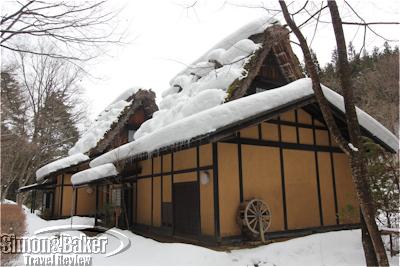
I arrived in the middle of winter
Visitors to Japan often make similar observations. I could treat myself to a decent shopping spree if I collected 100 yen for every time that I’ve heard, “Japan is clean! The people are very courteous! Japanese food is delicious!” In addition to positive responses, I have noted other surprises “Hotels here have small rooms. Trains sure are crowded.” And here’s my favorite, “I didn’t expect to walk so much!” With Japan’s excellent public transportation, people can cover the country and its massive cities with relative ease. However, for travelers used to touring by car, exploring Japan on foot can be unexpectedly tiring. Adding small hotel rooms to the mix can produce an even more tired traveler in Japan.
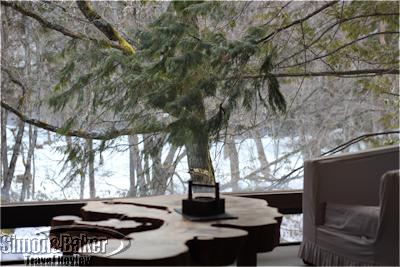
View from my room
For these reasons, a visitor’s experience in Japan would be incomplete without lodging in a ryokan, a Japanese inn. Ryokans offer much needed refuge from the road, and have comforted weary travelers in Japan for hundreds of years using the same formula: a healthy Japanese dinner and breakfast included with the room charge, spacious rooms, a warm public bath, and a fluffy Japanese futon spread on tatami-matted (bamboo reed mats) floors. Ryokans provide a wonderfully Japanese way of relaxing and recharging.
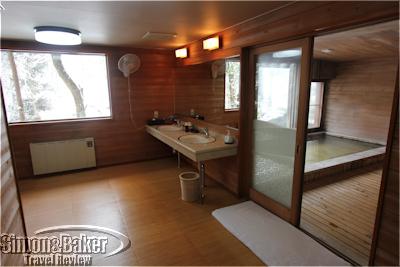
The men’s communal bathroom
While ryokans are very similar in service and amenities, none are constructed in cookie cutter fashion like many western hotel chains. A ryokan charms its lodgers with its unique characteristics related to design, location, and history. Some have been serving customers for hundreds of years while others have opened recently, designed in contemporary architectural styles, sometimes even blending Japanese customs with foreign ones, such as Arcanza Izu, which I previously wrote about (see With video – modern Japanese ryokan Arcana Izu creates magic in the mountains.)
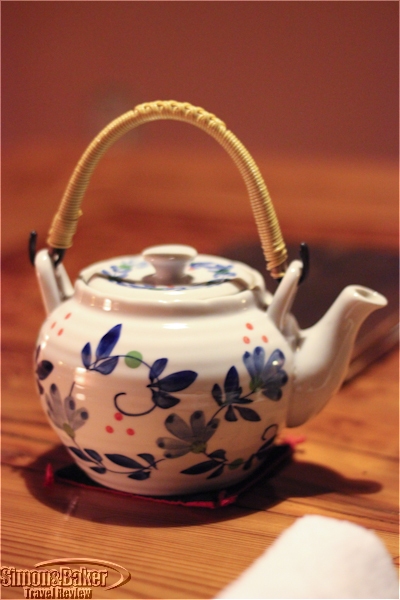
I had tea to warm the soul in the large lobby area.
For my friends exploring east and west Japan, I recommend staying at Wanosato, a delightful traditionally styled ryokan, at the crossroads of Japan. Little did I know at the time that I became part of a historical pattern of travelers seeking refuge in central Japan, where Wanosato is located. For thousands of years, travelers crossing the eastern and western power centers of Japan passed through what is now Gifu Prefecture. Lords, samurais, merchants, and other vagrants lodged at ryokans before resuming their journeys.

Wanosato icicles
To reach Wanosato I departed Tokyo Station for Takayama Station, near the Ryokan. After about a five hour train ride I took a 20-minute shuttle arranged by the inn. The driver pointed out the traditional architecture in the area and the Japanese Alps in the distance. Days before I had just been frolicking on sun kissed beaches, and now I was transported to an icy-world, blanketed with freshly fallen snow. I certainly could use some rest.
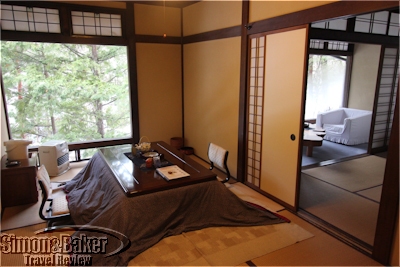
The sitting area in my room
I could have been fooled by Wanosato’s construction which took place only twenty years previously. The buildings were modeled after traditional Japanese architecture that emphasized nature. No concrete or steel there. Instead, buildings had distinctive thatched roofs on the outside and earthen floors and exposed wood on the inside.
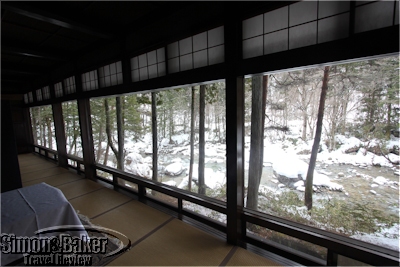
One of the main dining rooms features large panes of glass
When I entered the lobby of the main building I felt as if I had time traveled back to an era of samurai. The lobby was rectangular, framed by wood beams that appeared strong and beautiful. A raised hearth in the center warmed the room with a gentle fire while a massive iron pot rested above its flames. I sat on the tatami mats bordering the hearth and sipped on freshly brewed plum tea while I checked in. There was enough space around the hearth for well more than seven samurai.

Aya Tochimoto took great care of me
I had not been feeling well upon arrival. With the first sip of Wanosato’s warm tea I felt calmness envelop my body. At my first dinner, I told Aya Tochimoto, one of the two English speaking staff members, about my health condition. After that, I felt as if I had been taken under the wing of a caring family. She adjusted the menu to include gentle foods. For the first two days I was confined mostly to my room. However, Aya constantly checked on my condition and asked if I needed anything. Despite being low on energy, I felt that a steady diet of traditional Japanese food, cooked with locally grown vegetables and freshly acquired meat and fish, and daily dip in the ryokan’s beautiful public baths couldn’t hurt.

The Miya River
Eat, bathe, sleep, relax, repeat. I couldn’t feel more at ease in my room. It was divided into three sections: a main room where I slept, a living room with a delightful kotatsu, a Japanese table with blankets to keep warm, and a bathroom. I spent a lot of time nestled in my fluffy Japanese futon watching the spectacular view of the Miya River across the ryokan. On the second day, snow fell gently, coating the trees along the river.
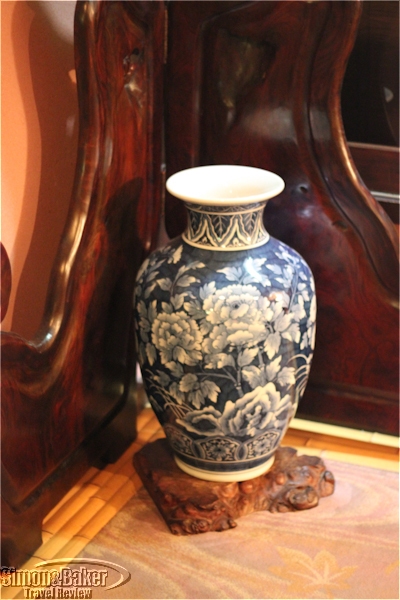
A beautiful vase on the third floor of the main building
On my third day, I finally felt enough energy to explore. I noticed fine examples of Japanese art throughout Wanosato. In the corner of the second floor hallway stood an exquisitely designed porcelain vase. In the main dining room hung elaborate scrolls. Next to the scrolls thought provoking ikebana, Japanese flower arrangements, stood proudly. Elaborate pictures were painted on sliding doors, making me pause contemplatively before opening them. On the way to the bath I noticed shisa, or stone guard dogs, whose slightly scary faces were thought to chase away evil spirits.
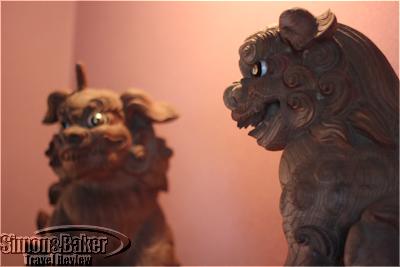
Mythical dogs were thought to drive away evil spirits
On the morning of my departure, I felt ready to hit the pavement again. The entire Wanosato staff accompanied me to the shuttle bus and bid me a safe journey home. The incredibly healthy traditional Japanese food, bone-warming baths, and the staff’s personal care energized me for my next adventure. Wanosato was exactly what this road weary traveler needed. Read more about my visit to Wanosato ryokan on the Simon and Baker Travel Review.
by Editor | May 21, 2012 | Accomodations, Attractions, New Articles
Article and photos by Josette King
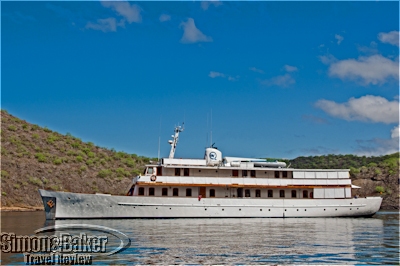
The M/Y Grace at anchor in a secluded cove of the Galapagos archipelago
After a 1,000-kilometer flight over empty Pacific Ocean waters, the AeroGal Airlines jet was preparing to land on San Cristobal, the easternmost island of the Galapagos Archipelago. The few returning locals were already gathering their belongings. Meanwhile, we the tourists were craning our necks to catch a first glimpse of the islands. The plane banked, revealing under its wing a zigzag of rocky coastline, punctuated by an occasional crescent of white sand; and no discernible sign of human life. Another turn unveiled a dazzling panorama of ancient volcanic peaks and dark rock formations emerging from an impossibly blue sea. All this natural splendor, and we hadn’t yet landed.
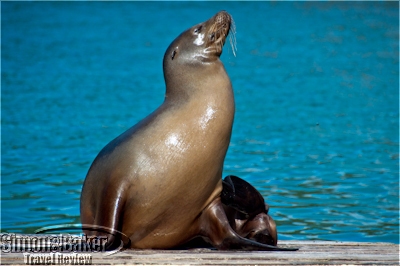
Galapagos sea lion
Once we did, I discovered another unique characteristic of the islands: the sense of undeniable entitlement of its wildlife. Even in the center of Puerto Baquerizo Moreno, the tiny provincial capital of the Galapagos adjacent to the airport, birds and reptiles and especially sea lions treated our presence with superb indifference. The later, enjoying their siesta sprawled on the boat dock, didn’t even twitch as I squeezed by to board the panga (local inflatable zodiac-type skiff) that was to take me to the Motor Yacht Grace.
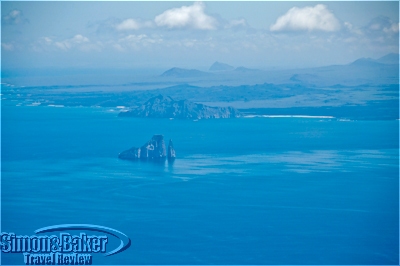
San Cristobal landing
My first glance at the elegant lines of this classic yacht was a special thrill. It brought back fantasies I had shared with an entire generation of French schoolgirls half a century before. Its owner was Prince Rainer III then, and it was named the Deo Juvante (Latin for with God’s help) after the motto of the house of Grimaldi, the rulers of the tiny French Riviera principality of Monaco for almost a millennium. For a few weeks in 1956, it had been front page news on French magazines and movies screens: the prince, sailing to meet the ocean liner USS Constitution to welcome his fiancee, the American movie star Grace Kelly; then the following week, Prince Rainer and the now Princess Grace boarding the yacht again for a seven-week honeymoon. Throughout the spring, there had been images of the yacht anchored in the most romantic destinations around the Mediterranean. Now this glamorous vessel was to be my home for a seven-night cruise around the Galapagos Archipelago, royal matrimony not required.
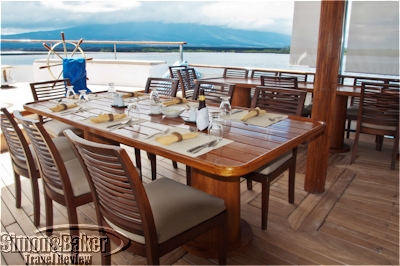
The shaded fresco dining area at the rear of the main deck
The yacht, renamed the M/Y Grace in homage to its most illustrious owner, is now the property of Quasar Galapagos Expeditions. Its owner Eduardo Diez, a man with a passion for classic yachts, oversaw a two-year, $2.5 million overhaul of the ship, while preserving its distinctive lines. The Grace, newly outfitted with a state-of-the-art stabilizer system to ensure smooth sailing on the open waters around the Galapagos islands, a large hot tub on the sundeck, modern bathrooms in each of its nine staterooms and air conditioning throughout, began operations in the spring of 2009. While I admit that it was the prospect of sailing on the Grace that propelled my desire to visit the Galapagos “some day” to the top of my travel wish list, the understated luxury of the vessel turned out to be merely the setting for a unique wilderness adventure. With only seven passengers and a crew of 10 on board, our naturalist guide, Rafael Pesantes Aguirre (Rafa for short) quipped that our odds for mutiny were unpromising.
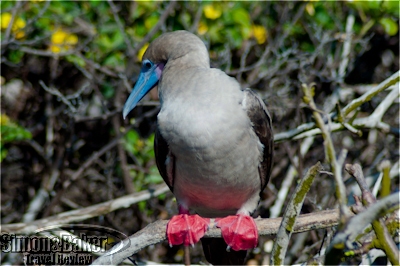
Red footed booby
But between the attentive pampering of the friendly staff and the exhilarating daily discoveries of the cruise, mutiny was the last thing on my mind. The exceptional itinerary took us to remote places rarely visited by larger ships. And Rafa, a third generation native of the islands and an ornithology graduate from San Francisco University in Quito, coupled an encyclopedic knowledge of the natural wonders of the area with the familiarity of one who has swum since childhood in the crystal clear waters of its most secluded coves. Our land excursions were filled with close encounters with some of rarest wildlife on the planet. We wandered on powdery white beaches shared only with colonies of sea lions and hiked along black lava rock paths to observe at close range the courtship ritual of Nazca boobies and waved albatross.
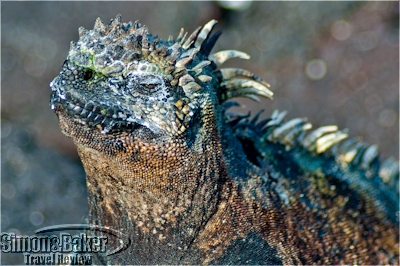
Fernandina marine iguana
We rode our panga along the edge of vertical cliffs dotted with blue-footed boobies and tiny Galapagos penguins, and watched frigate birds and brown pelicans nosedive for their breakfast. For me the highpoint of the day was invariably our snorkeling expedition. In island after island, Rafa led us to the most exotic marine life I have ever observed. I swan surrounded by so many giant sea turtles that it was a challenge to get out of their way. I observed a hammerhead shark, mercifully unconcerned by my presence; and I can now boast that I was personally pecked by a flightless cormorant! Visit the Simon & Baker Travel Review to read more about my Galapagos Archipelago cruise aboard the M/Y Grace.
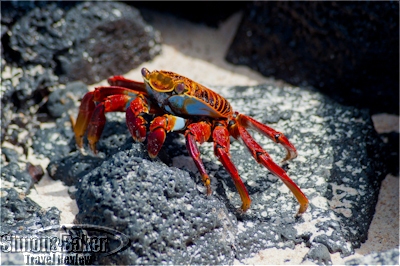
Sally Lightfoot crab
by Editor | Apr 23, 2012 | Accomodations, Attractions, Ecotourism, New Articles
Article and photos by Josette King

Hoatzin birds were a frequent sight near the lodge
“Stop, stop!” I sputter, too excited to keep my voice down. Fabian, the local park ranger who is paddling, doesn’t speak English but he gets the idea and brings the canoe to a smooth halt. Roberto, my Ecuadorian guide who speaks English fluently, looks at me askance. He has just pointed out a large bird perched in the dense jumble of rainforest. It looks like a chicken with too much turquoise eye shadow and a bad hair day. “The bird,” I exclaim. “Yes, it’s a hoatzin,” he reiterates matter-of-factly. He clearly fails to grasp the importance of the moment. So does the bird, which has by now been joined by two of its friends. They are engaged in a croaky argument while heartily tucking into the foliage. I feel compelled to explain that on a previous Amazon visit, a thousand miles downriver from here, I had once spent a whole week, including a half-day hike in the waterlogged underbrush, in search of a hoatzin. And I had only managed to hear its distinctive cry and ponderous take off as it vanished into the forest canopy. “We have lots of hoatzins here,” Roberto assures me after I have photographed these to my heart’s content, and for good measure a rare rufescent-tiger heron that has been observing the proceedings from a nearby stump.
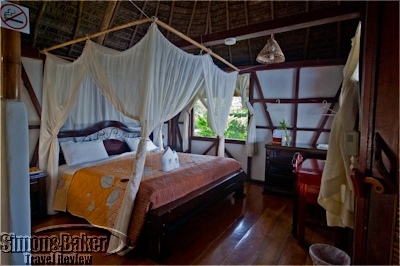
The king size bed was draped in mosquito netting
We resume our slow way upstream under an arch of tangled mangroves and palms, along the narrow channel that connects the Napo River, one of the most important tributaries of the Amazon, to Anangucocha Lake. We are in the heart of 21,400 hectares (82 square miles) of conservation land located on the ancestral territory of the Kichwa Anangu community, in the northwest corner of Ecuador’s Yasuni National Park. The park is a UNESCO Biosphere Reserve regarded by scientists as one of the most bio-diverse areas on the planet. Several notable sightings later, including a tree-toed sloth and my first ever monk saki monkey, we reach the lake. On its far side, the shore is dotted with the thatched-roofed, bright ocher adobe bungalows of the Napo Wildlife Center luxury eco-lodge.
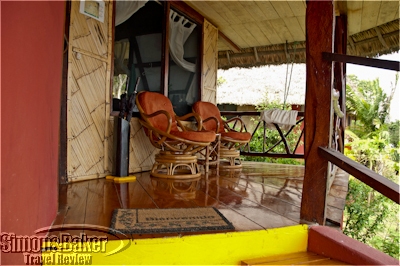
My bungalow had a shaded terrace overlooking the lake
Set into some of the most pristine rainforest environment I have ever visited, the lodge is designed to meet the high expectations of international tourists for wilderness accommodations. It features attractive bungalows with private terraces overlooking the lake, modern bathrooms, round the clock electricity and WiFi connection throughout the property. Strategically located observation towers at the lodge and in the forest offer a unique perspective of the abundant wildlife around the lake and above the forest canopy. My wildlife viewing is exceptional, not only for its abundance and variety but because of the excellence of the guiding. At the lodge, guides come in pairs: a bilingual, state-licensed guide and a native Yasuni Park-licensed ranger who also acts as a local guide, sharing his knowledge of plants, medicinal plants and Kichwa traditions. One evening, they take me on a nighttime canoe ride in the swamps near the lodge, with a special spotlight to view nocturnal creatures.
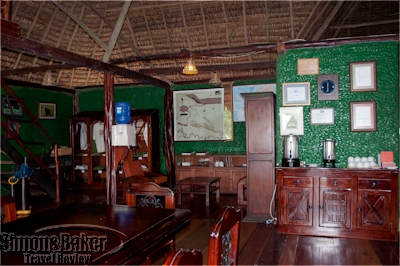
Coffee was served around the clock in the main hall
Beyond the excellence of accommodations and wildlife viewing opportunities, a highpoint of my visit is the opportunity to observe first hand the positive impact of the Napo Wildlife Center on the daily life of the Anangu people. The lodge and conservation land are wholly owned and managed by the Kichwa Anangu community. They are the keystones of a far-reaching program to improve the quality of life of the people and preserve the integrity of their ancestral territory and culture while providing them with sustainable employment. Most of the staff comes from the community. Their pride in the Napo Wildlife Center is palpable, and translates into warm and attentive service. Additionally, while the life of the community is separated from tourism activities, one hour downstream from the lodge, I see women welcome guests to the Interpretation Center facility adjacent to their village. It is especially rewarding to be able to connect with them (with Roberto as interpreter) as they introduce me to the tasks of their daily lives as well as their traditional Kichwa crafts and dances.
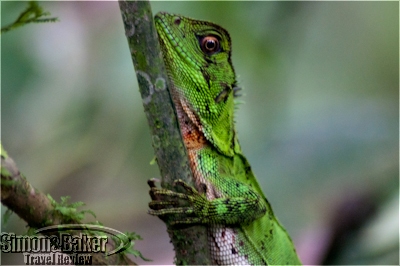
An Amazon forest dragon
I am gratified to hear of the rigorous sustainable tourism practices implemented by the Napo Wildlife Center program. Profits are reinvested within the community, with education and healthcare as major priorities. The center also returns a share of the annual profits to each family and provides a stipend to the elderly. To limit the lodge’s impact on its environment, it has implemented an environmentally sustainable sewage system, with waste waters treated to high standards before being released into the swamps. Trash is kept to a minimum and composted whenever possible. What is safe to burn is burned and buried, with the remainder transported to designated landfills outside the park. And these practices have been extended to the Anangu community at large, for a cleaner, healthier living environment.
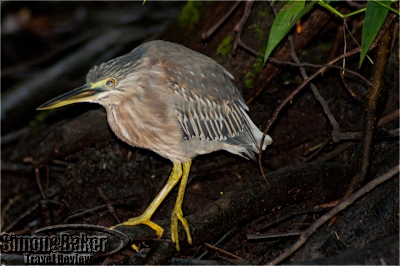
A striated heron
The Napo Wildlife Center is also engaged in a strong anti-poaching program, with its conservation land patrolled by community rangers employed and equipped by the lodge. The Napo Wildlife Center was recognized in 2009 with the Rainforest Alliance Community Sustainable Trend Setter Award, and the Best Jungle Lodge Award from the Latin American Travel Association at the World Travel Market in London, U.K. And it is becoming a model for other sustainable tourism community projects throughout Ecuador.
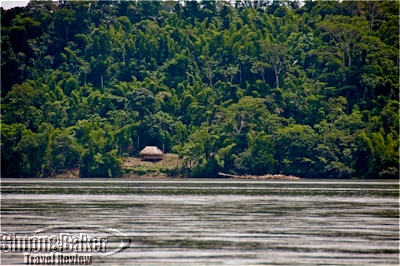
The banks of the Napo River were a tangle of dense rainforest
And by the way, Roberto was right. We came across so many hoatzins during my four-day visit that by the time I left, I barely spared them a glance. Visit the Simon & Baker Travel Review to read more about my stay at the Napo Wildlife Center.























































